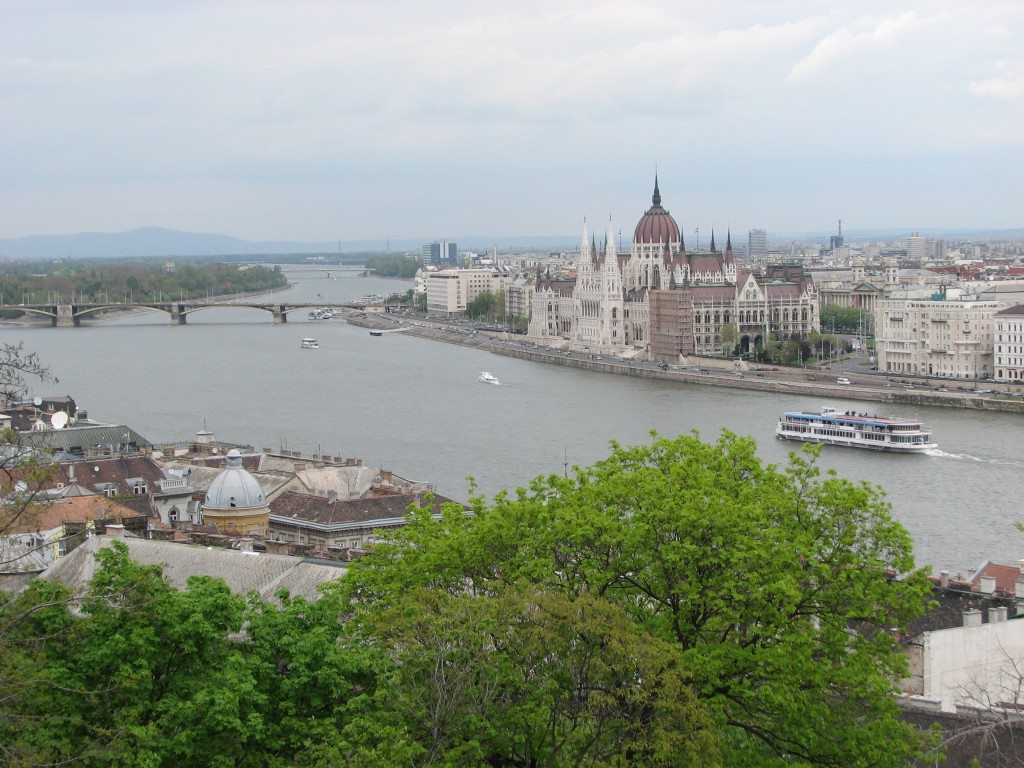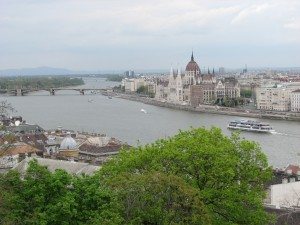 We just got back from a long weekend in Budapest. We took the kids out of school on Friday, caught an early train across the Hungarian plain, and were standing on the train station steps in Pest before noon. Unfortunately for us, the city transit workers decided to strike, which left us with a city map from the tourist kiosk, the address of the apartment rental agency I got from the internet, and a four-subway-stop walk. On the way I was impressed by the amount of graffiti and the boldness of the taggers to autograph just about anything. We by passed two Burger Kings on the way to our first Hungarian meal at an Italian restaurant, choosing the comfort of pizza for hungry and tired kids rather than new culinary discoveries. Our apartment is only a few hundred meters from the rental agency, on a pedestrian-only street in the main shopping neighborhood of Pest. It has one room with a very tall ceiling that allowed the construction of a loft and enough beds for all of us. It has windows overlooking the street, which is relatively quiet.
We just got back from a long weekend in Budapest. We took the kids out of school on Friday, caught an early train across the Hungarian plain, and were standing on the train station steps in Pest before noon. Unfortunately for us, the city transit workers decided to strike, which left us with a city map from the tourist kiosk, the address of the apartment rental agency I got from the internet, and a four-subway-stop walk. On the way I was impressed by the amount of graffiti and the boldness of the taggers to autograph just about anything. We by passed two Burger Kings on the way to our first Hungarian meal at an Italian restaurant, choosing the comfort of pizza for hungry and tired kids rather than new culinary discoveries. Our apartment is only a few hundred meters from the rental agency, on a pedestrian-only street in the main shopping neighborhood of Pest. It has one room with a very tall ceiling that allowed the construction of a loft and enough beds for all of us. It has windows overlooking the street, which is relatively quiet.
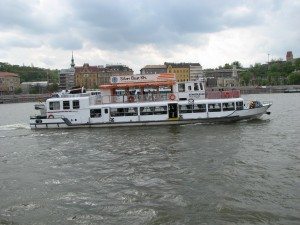 Since taxis have a reputation for overcharging, our only choice is to keep walking. One of the advertisements on the edge of my map is for a boat ride, and we figure that to be a good introduction to the city (and you know Ashley has a thing for boats). So we head towards the Danube two blocks away to find the dock. The river flows fast from snowmelt in the Alps, and the hills of Buda are on the other side the river. The river’s width makes it more imposing than the Thames or the Seine. It turns out that there are many tourist boat options, but the one from my map includes two drinks with each ticket, so we decide with our thirst. They serve us in our seats outside on the deck, where we can listen on headphones to a recorded guide
Since taxis have a reputation for overcharging, our only choice is to keep walking. One of the advertisements on the edge of my map is for a boat ride, and we figure that to be a good introduction to the city (and you know Ashley has a thing for boats). So we head towards the Danube two blocks away to find the dock. The river flows fast from snowmelt in the Alps, and the hills of Buda are on the other side the river. The river’s width makes it more imposing than the Thames or the Seine. It turns out that there are many tourist boat options, but the one from my map includes two drinks with each ticket, so we decide with our thirst. They serve us in our seats outside on the deck, where we can listen on headphones to a recorded guide 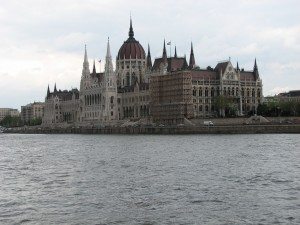 in 30 languages. There’s Fisherman’s Bastion, the palace, the citadel, and the Gellert Baths in Buda, and the parliament, the university, and the Great Market Hall in Pest. Not to mention Margaret Island, a park in the middle of the river, and the many bridges spanning between Buda and Pest. The only blight on the landscape is the newish Hilton Hotel, an ugly golden building enveloping the ruins of a centuries old church smack dab in the middle of Castle Hill. It looks like the local officials were a little too eager to accommodate western investment after the fall of the iron curtain. (Insert Paris Hilton joke here)
in 30 languages. There’s Fisherman’s Bastion, the palace, the citadel, and the Gellert Baths in Buda, and the parliament, the university, and the Great Market Hall in Pest. Not to mention Margaret Island, a park in the middle of the river, and the many bridges spanning between Buda and Pest. The only blight on the landscape is the newish Hilton Hotel, an ugly golden building enveloping the ruins of a centuries old church smack dab in the middle of Castle Hill. It looks like the local officials were a little too eager to accommodate western investment after the fall of the iron curtain. (Insert Paris Hilton joke here)
After the boat ride we crossed the Chain Bridge and took the funicular up Castle Hill. But instead of going into the museums of the palace, we hit the tchochke shops out in front and headed into the walled old city in search of the labyrinth of caves underneath. We found the entrance gated and a nearby shop owner saying they are permanently closed, although she didn’t why. So we look out over the city from Fisherman’s Bastion and then look for dinner. On our serendipitous 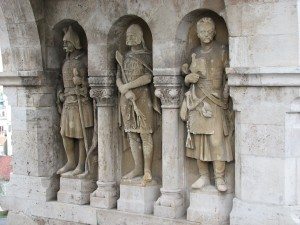 search, a compassionate security guard at the Vienna Gate (one of access points through the city wall) gives us a couple of rolls from his dinner to stave off our hunger for a few minutes longer. Eventually, we find our way to the base of the hill again and down into a basement restaurant that doesn’t get many tourists. We all order things we’ve never had before, and only Logan balks at her plate of eggplant (she quickly gets it replaced with a bowl of pasta by the friendly owner). It’s fun if not tasty.
search, a compassionate security guard at the Vienna Gate (one of access points through the city wall) gives us a couple of rolls from his dinner to stave off our hunger for a few minutes longer. Eventually, we find our way to the base of the hill again and down into a basement restaurant that doesn’t get many tourists. We all order things we’ve never had before, and only Logan balks at her plate of eggplant (she quickly gets it replaced with a bowl of pasta by the friendly owner). It’s fun if not tasty.
The next morning, after a quick breakfast at Eastern Europe’s version of Starbucks called “Coffee Heaven,” we jump on a bus (the strike lasted only for one day) to the Gellert Baths. We’re all excited because we’ve heard Ashley’s story about going to these baths 20 years ago, it is Budapest’s most famous spa, and its all about swimming! I’m a little worried, though, about some of the spa’s reputation – men and women in separate baths, lots of senior citizen naked flesh, body-bruising massages. Will they let the kids in? But there is no more segregation (apparently even in the changing rooms), nobody is naked (and very few speedos), and the kids can go anywhere they want. There is a hotel from 1918 attached to the baths and people still come for the healing powers of the water, but they come now in greater numbers as tourists like us. The indoor pools are ornately tiled with pillars holding up glass ceilings. We start in the cool swimming pool (26ºC), but quickly end up in the warm pool (30ºC), where moving around (e.g., playing) is frowned upon. Ashley heads off for a massage, and the girls and I head outside to find the wave pool. Though it’s the biggest pool in the place, the waves don’t start until May, and we’re left playing games in the shallow end. Eventually a bus load of Japanese tourists are waving at us from outside the fence, and we realize that we’re the only ones in the big cool pool (26ºC) in the rain. When Ashley comes back we head for the inner sanctum of hot pools (36-38ºC). After a few minutes of soaking, I follow a trickle of people going into the steam room. Inside it’s hard to see more than few feet and it hurts to breath. I’m reminded of mafia dons wrapped in white towels reminiscing about the Hoffa days. After a few minutes it’s too hot move – it must be something about the sweat on my skin interacting with the hot steam. A large man behind me and up on a step, where it’s even hotter, mutters something about “first time short,” so I head out and immerse myself in the cold bath, which feels downright arctic. I repeat this process two more times, never getting higher than the first step (there are three), before I retire back to the hot pools, and then the warm pools, and then the cool swimming pools again. After three hours our skin is all sharpei.
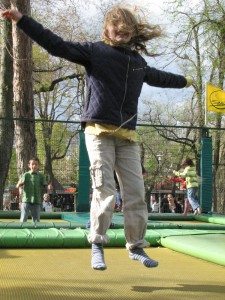 We don’t make it past the hotel restaurant for lunch, and then onto the subway to City Park on the other side of Pest. Within 15 minutes Logan has ridden a pony and Zoey has jumped on a trampoline. We have to talk them out of the circus (it has animal acts which may be heart-wrenching) and the amusement park (it would cost about $100 for an hour of rides). We end up under a tent drinking beer and playing games as a thunderstorm passes by, and then to a wine cellar eating some fabulous food. One benefit for us in Budapest is that we can afford nice meals that are out of our reach in Vienna. On the way home we see the nighttime lights of Heroes Square and the bridges and palaces along the Danube.
We don’t make it past the hotel restaurant for lunch, and then onto the subway to City Park on the other side of Pest. Within 15 minutes Logan has ridden a pony and Zoey has jumped on a trampoline. We have to talk them out of the circus (it has animal acts which may be heart-wrenching) and the amusement park (it would cost about $100 for an hour of rides). We end up under a tent drinking beer and playing games as a thunderstorm passes by, and then to a wine cellar eating some fabulous food. One benefit for us in Budapest is that we can afford nice meals that are out of our reach in Vienna. On the way home we see the nighttime lights of Heroes Square and the bridges and palaces along the Danube.
After breakfast on Sunday morning Ashley and Logan head for the train station to catch a birthday party back in Vienna in the afternoon. Zoey and I figure out the bus system to get out of town to the Statue Park, where communist-era 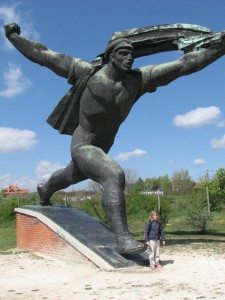 statues have been relegated. I started to take pictures of the public art associated with the socialist-era housing in Vienna, and I’ve always been intrigued by the Soviet Lenin statue that ended up as Seattle public art a few years ago, so I figured this park could be cool. There are fewer of the really large worker statues than I was expecting, but what they have are nonetheless impressive and Zoey takes pictures of all of them to show Logan. It’s hard to imagine that just a couple of decades ago there were no Burger Kings or Coffee Heavens or Apartment rental agencies anywhere to be found. Back in Pest, Zoey and I share lunch in the warm sun at a sidewalk café in front of Saint Stephen’s Basilica. We cut it a little close and have to run to catch our train back to Vienna, getting home in time for dinner. Budapest is as far from Vienna as Portland is from Seattle, but the comparisons really stop there.
statues have been relegated. I started to take pictures of the public art associated with the socialist-era housing in Vienna, and I’ve always been intrigued by the Soviet Lenin statue that ended up as Seattle public art a few years ago, so I figured this park could be cool. There are fewer of the really large worker statues than I was expecting, but what they have are nonetheless impressive and Zoey takes pictures of all of them to show Logan. It’s hard to imagine that just a couple of decades ago there were no Burger Kings or Coffee Heavens or Apartment rental agencies anywhere to be found. Back in Pest, Zoey and I share lunch in the warm sun at a sidewalk café in front of Saint Stephen’s Basilica. We cut it a little close and have to run to catch our train back to Vienna, getting home in time for dinner. Budapest is as far from Vienna as Portland is from Seattle, but the comparisons really stop there.

